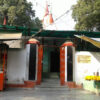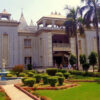- Empty cart.
- Continue Shopping
Temples of Kashi – Kashi Vishwanath Temple

The Kashi Vishwanath, a manifestation of Lord Shiva, is the patron deity of Varanasi. The idol is a jyotirlinga, one of the 12 jyotirlingas in India. The Kashi Vishwanath temple has been built and re-built several times over the past few centuries. The present temple was built in the 18th century by Rani Ahalyabai Holkar of Indore after Mughal emperor Aurangzeb destroyed the previous temple and built a mosque at the site (now adjacent to it). The temple get its name from Kashi, which is another name for Varanasi.
HISTORY
The Kashi Vishwanath temple is one of the most popular Hindu pilgrim centres of India. It also finds a mention in old religious texts like the Skanda Purana. The aarti held at this temple is one of the most majestic experiences you can have on a trip to India.
The temple stands on the western bank of the holy river Ganga, and is one of the 12 Jyotirlingas, making it the holiest of Shiva temples.
It has been destroyed and re-constructed a number of times in several Islamic invasions of India. It was last demolished by Aurangzeb, the sixth Mughal emperor who then carried out an un-Islamic act of constructing a mosque on the site where the demolished temple was situated.
The current existing Kashi Vishwanath temple has been built on an adjacent site by the Maratha ruler, Ahilya Bai Holkar of Indore in 1780, and not on the original site where a functioning mosque today stands. Maharaja Ranjit Singh, the first Sikh Maharaja, had donated 1 ton gold for the new temple’s dome.
In 1983, the management of this temple was taken over by the government of Uttar Pradesh. It is still under government management.
During the religious occasion of Shivratri, The “Kashi Naresh” (King of Kashi) is designated chief officiating priest. The original Gyanvapi Kashi Visvanath temple is mentioned in the ancient Puranas including in the Kashi Khanda (section) of Skanda Purana.
The original Gyanvapi Kashi Vishwanath temple was destroyed by the army despatched by Mohammed Ghori in 1194 AD, when it had defeated the Raja of Kannauj. In 1192 AD, Ghori had been crowned as Emperor in Delhi after defeating Prithviraj Chauhan.
The temple was rebuilt by a Gujarati merchant during the reign of Delhi’s Sultan (1211-1266AD). It was demolished again during the rule of either Hussain Shah Sharqi (1447-1458) or Sikandar Lodhi (1489-1517).
Raja Man Singh of Jaipur thereafter built the temple during Mughal Emperor Akbar’s rule, but some Hindus boycotted it. Raja Todar Mal further renovated the temple with Akbar’s funding at its original site in 1585.
In 1669 AD, the Gyanvapi Temple was again destroyed because of a firman issued by Emperor Aurangzeb and to ensure it was not rebuilt, as it was on earlier occasions, he got constructed the present “Gyanvapi” Mosque in its place thereby, in, according to Syed Shahabuddin, violation of Islamic law as stated in the Hadith, which states it is haram to build on usurped sites [such as of religious sites of other faiths].
The remains of the erstwhile temple were used for mosque construction which can be seen in the foundation of the mosque, the columns, and a chamber at the rear part of the mosque visible as part of the temple.
In 1742, the Maratha ruler Malhar Rao Holkar made a plan to demolish the mosque and reconstruct the temple again at the site. However, his plan did not materialise, partially because of intervention by the Nawab of Awadh, who had been given the control of the territory.
Around 1750, the then Maharaja of Jaipur commissioned a survey of the land around the site, with the objective of purchasing land to rebuild the Kashi Vishwanath temple. However, his plan to rebuild the temple did not materialise.
In 1780, Malhar Rao’s daughter-in-law, Ahilyabai Holkar constructed the present temple adjacent to the mosque as a temporary measure. That is what is seen when Hindus go for darshan to Varanasi.
FAITH OF HINDUS
As per the Shiva Purana, once Brahma (the Hindu God of creation) and Vishnu (the Hindu God of Preservation) had an argument about who was supreme. To test them, Shiva pierced the three worlds as a huge endless pillar of light, the jyotirlinga, to determine who was mightier. Vishnu took the form of Varaha and sought out the bottom while Brahma took the form of a swan to fly to the pillar’s top.
The jyotirlinga shrines, thus, are places where Shiva appeared as a fiery column of light. There are 64 forms of Shiva, not to be confused with Jyotirlingas. Thus Jyotirlinga being a matter of faith, it cannot be questioned.
AT PRESENT
The 50-feet-wide Kashi Vishwanath Corridor work is going on that will connect the ancient shrine and one of the 12 Jyotirlinga temples to the famous ghats of Varanasi. The main temple, Kashi Vishwanath temple, which is located on the left bank of the holy river Ganga is surrounded by narrow and small, claustrophobic lanes. The prime place of worship in the city, and perhaps the country, struggles to manage humongous crowds in its congested lanes during festive times, which is literally around the year. Roughly 3,000 – 5,000 people visit the temple every day and on special occasions like Mahashivratri and Shravan month it reaches over 1 to 3 lakh.
Proposed Features of Corridor:-
– An approximately over 50-feet corridor will directly connect Ganga’s Manikarnika and Lalita Ghat to the Kashi Vishwanath Jyotirlinga Temple
– The riverfront will upgrade ghats on Ganga river
– The corridor will have waiting rooms for the pilgrims to rest
– On the way, pilgrims and travellers will see the newly built museum and auditorium depicting Varanasi’s ancient history and culture
– There will be new Yagyashalas for religious functions like havan and Yagya.
– The Kashi Vishwanath corridor will reportedly have lodgings for priests, volunteers and pilgrims
– The enquiry centre in the corridor will help the tourists about the city and its other places of attractions and amenities
– Just before the Kashi Vishwanath Temple, the corridor will culminate in a big, majestic square
– Food street which will serve tourists and pilgrims luscious Banarasi and Awadhi dishes
– A new Bhogshala will be constructed for offerings to the presiding deity
– For gatherings, meetings and temple functions, an auditorium will be constructed which will facilitate these events
on the other way, Banaras is known for its narrow lanes in the old city, meanwhile many peoples feel that this project is demolishing the oldness of Banaras.






